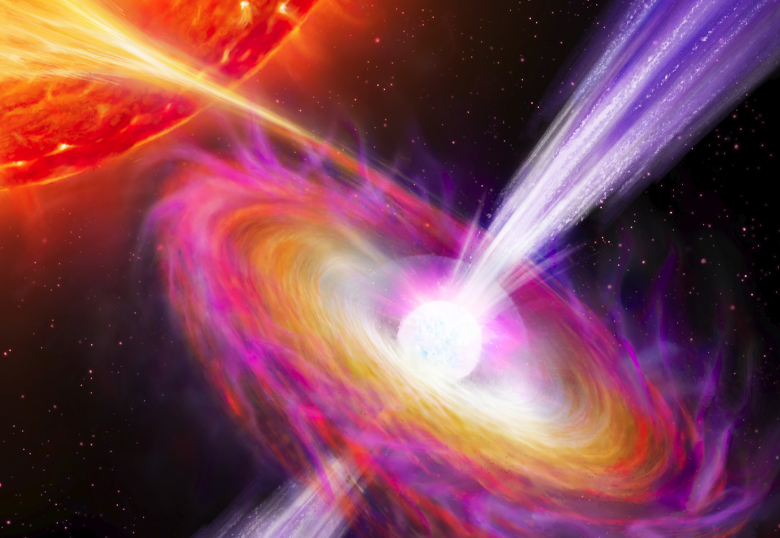An international team of astronomers, including University of Lethbridge astrophysicist Dr. Alex Tetarenko, have performed a unique experiment probing astrophysical jets being expelled into space at nearly the speed of light. The material and energy in these jets was liberated when huge explosions occurred on the surface of a celestial object called a neutron star.

Jets are a common astrophysical phenomenon produced by many different objects but studying them is often very difficult because these streams of matter are too far away from Earth to directly track material moving along the jet flow in real time.
“To get around this problem, we came up with an experiment involving neutron star systems to open up a new avenue of investigation on these jets,” explains Tetarenko.
Neutron stars are super-compact stellar corpses. When located in orbit with another star, the neutron star’s intense gravitational field can end up pulling material off its companion. Part of this accreted matter is then ejected out into jets that race away along the neutron star’s rotation axis, while the rest spirals down onto the neutron star surface. As more and more material rains down onto the neutron star, the gravitational field compresses it until a runaway nuclear explosion is initiated. This creates a cataclysmic thermonuclear blast known as a type-I X-ray burst.

To date, these bursts have been seen from hundreds of different neutron star systems and can occur as regularly as every few hours. Tetarenko and her team reasoned that in these systems, the sudden liberation of matter and energy from the surface of the neutron star during these bursts would affect the jet, and they could measure this disturbance as it propagated outwards.
“We have a very brief short-lived impulse of extra material that gets shot into the jet and that we can track as it moves down the jet to learn about its speed,” says Dr. Thomas Russell, lead author on the publication from the National Institute for Astrophysics in Italy.
“This is a particularly crucial measurement, as the jet speed in these neutron star systems can reveal whether the jet is powered by magnetic fields anchored in the accreting material or in the star itself,” explains Tetarenko.
While the explosions on the surface of the neutron star were visible in X-ray light, the jet only emits in radio light. Therefore, Tetarenko and her team needed to coordinate radio telescope observations on the ground to take place simultaneously with X-ray telescope observations in space.
“These bursts reoccur every couple of hours, but you can't predict exactly when they will happen. So, you have to stare at the system for a long time with these two telescopes and hope you catch a couple of bursts,” says co-author Dr. Jakob van den Eijnden, University of Warwick, UK.
The team’s radio observations were taken over a three-day period with the Australia Telescope Compact Array (ATCA) , while X-ray observations were taken with the INTEGRAL Satellite. At the end of the observations, INTEGRAL had captured 14 X-ray bursts from the neutron star 4U 1728-34, of which 10 occurred when the source was visible in radio light to the ATCA.
“We originally thought that the explosion on the surface of the neutron star would destroy the location where the jet was being launched. But we saw exactly the opposite: a strong input into the jet rather than a disruption,” says co-author Prof. Nathalie Degenaar, University of Amsterdam, The Netherlands.
Being able to follow the injected extra matter down the jet in radio light allowed Tetarenko to apply her custom computational modeling techniques to accurately calculate the speed of the material being launched down the jet, finding a value nearly 40 per cent the speed of light!
“Never before have we been able to anticipate and directly watch how a certain amount of gas got channeled into a jet and accelerated into space,” says Dr. Erik Kuulkers, project scientist at INTEGRAL and co-author on the paper.
Having now proved that this is possible and appears to be common in bursting neutron stars, the technique will allow astronomers to study many more of these objects. These future studies will connect the launching of jets to specific properties of neutron stars (such as its rotation rate and the amount of gas falling onto it), which is one of the most pressing questions about how astrophysical jets work.
“The impact of our work will extend far beyond neutron stars,” explains Tetarenko.
Jets play an important role throughout the universe, from transporting exotic elements synthesised in cosmic explosions into interstellar space, to heating surrounding gas clouds that will alter how and where new stars can form. As all astrophysical jets are thought to be launched in similar ways, the team’s new results will have wide applicability across the cosmos.
The results were published in the journal Nature today, Thermonuclear explosions on neutron stars reveal the speed and feeding of their jets.
